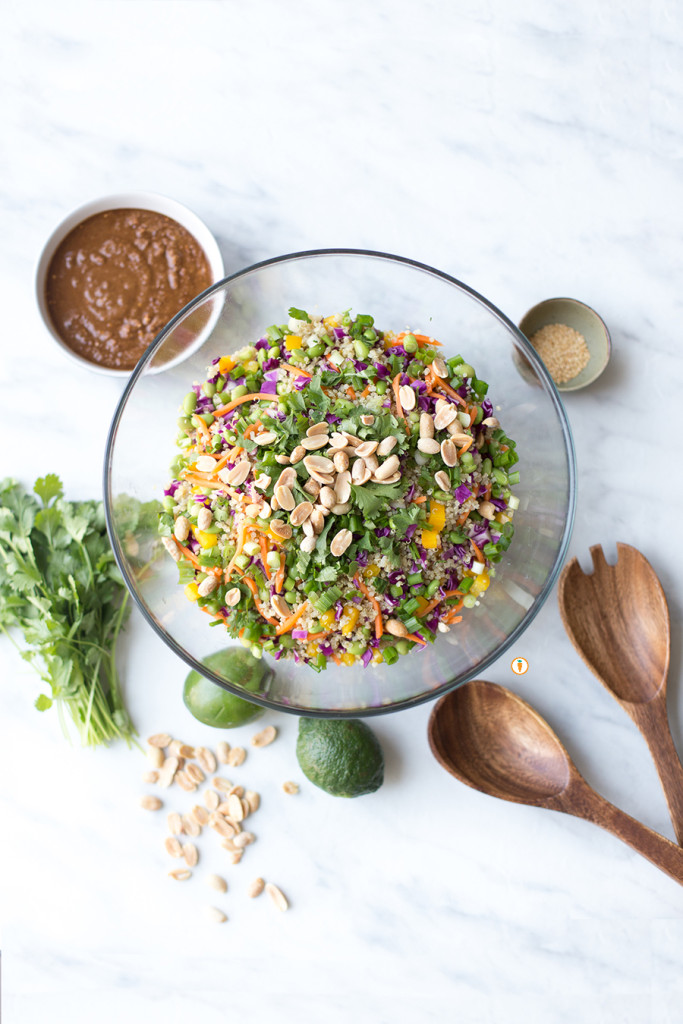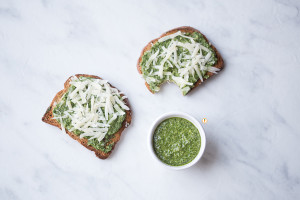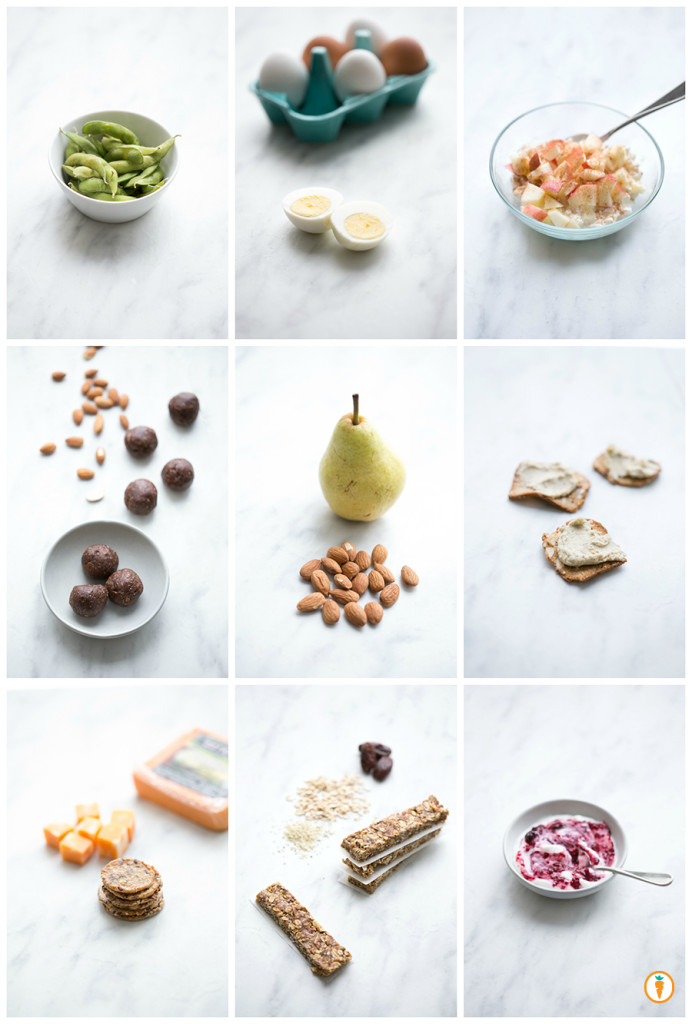
Snack ideas galore!
How (and what) we eat has changed. As a nation we are shifting from 3 meals a day to multiple small meals, or 3 meals and 3 snacks. Back in the day our grandmas didn’t have time to make more than three meals since they were all from scratch, and our grandpas didn’t have time to eat more than 3 meals because they worked sun-up to sun down.
Now, with working households, evolving research and a shift in the eating paradigm our days are certainly not what they once were. A day in the office might look like this; coffee, emails, yogurt, conference call, donut, coffee, emails, lunch, meetings, granola bar, dinner, TV, snacks, social media, bed. Repeat.
Sound familiar? Vaguely?
There is no problem with eating 6 smaller meals a day. In fact about 16% of Canadians are doing it1. Societal demands persuade us to work faster and longer. Time for meals has fallen to the wayside and we are all guilty of eating in the car or eating while scrolling through instagram. However, snacking may be adding calories that we would not have eaten had we stuck to 3 smaller meals. Many snacks nowadays also include a nutrient-lacking drink. A juice box, iced tea or a fancy latte etc. It doesn’t sound too harmful until we look at the 200+ extra calories we are (quickly) ingesting. Not to mention, when we dissect where these calories come from, they often aren’t nourishing. Pair one of these beverages with 200 calories of food and you have a 400 hundred calorie snack meal. Oops.
In order to stop this from happening we need to be mindful of consumption and ensure that we are getting all the nutrients we need from our combination of meals and snacks.
Here’s a bit more guidance:
One.
Just because it says snack or snack pack or snak pax or however the kids are spelling it these days doesn’t mean that it is healthy. Those granola bars and gummy packs are sugar laden regardless if they are made with “real fruit juice” or not. Solution? Homemade granola bars, and a small container of berries or grapes for a sweet bite with the added fibre of natural fruit.
Two.
Just like chocolate bars and ice cream, chips, muffins and cookies are treats. Now there’s nothing wrong with a homemade carrot muffin or a nutrient dense oatmeal cookie in you or your little one’s lunch. But recognize this is a “dessert” or a “treat”.
Fun fact – Tim Horton’s muffins have, on average, 100 more calories than their donuts. Yikes. Maybe we should start calling them cupcakes.
Three.
Include multiple food groups. Aim for 2-3 food groups per snack! It’s important to include a protein and carbohydrate. Benefits of this strategic pairing includes increased alertness, stable sugars and sustained energy. Some examples include cheese & grapes, or nuts with an apple, chicken & cherry tomatoes with a little balsamic vinegar, raw veggies with hummus, banana with almond butter, cottage cheese with black pepper and baby carrots, the list goes on!
Four.
You don’t neeeed to have snacks. As much fun as “eating-cause-I’m-bored” is…it definitely isn’t necessary. Listen to your body and eat when you experience real hunger cues. Start by drinking a cup of water, then if your body demands it, go ahead! Get nourished!
Remember, just like a meal is for nourishment, so are your snacks. You might need a little power in the mid afternoon to get you through the rest of your workday. So make it count. Give your body what it needs. A donut will result in a sugar crash, a handful of almonds and berries will give you human super powers to have the most productive 2-4pm you’ve had all week. Or something like that…
Now, in case you’re interested pictured above are the top 9 snacks I tend to rotate between (from left to right):
- steamed edamame beans
- a hardboiled egg
- cottage cheese with apple and cinnamon
- energy date balls
- pear with a handful of almonds
- crackers with white bean spread
- cheddar cheese with Mary’s Gone crackers
- no bake granola bars
- plain Greek yogurt with 5 ingredient berry sauce
Food photography done by the talented Ceone Dyck. To learn more about Ceone click here or follow her on Facebook.
Please note the content of this post was written by 4th year Human Nutritional Sciences student Johanna Adriaansen. Johanna also maintains her own website and is an aspiring Dietitian!
Don’t forget to follow Carrots and Cake on Instagram to see tiny square snap shots of my life.
– With Love, Carrots and Cake,

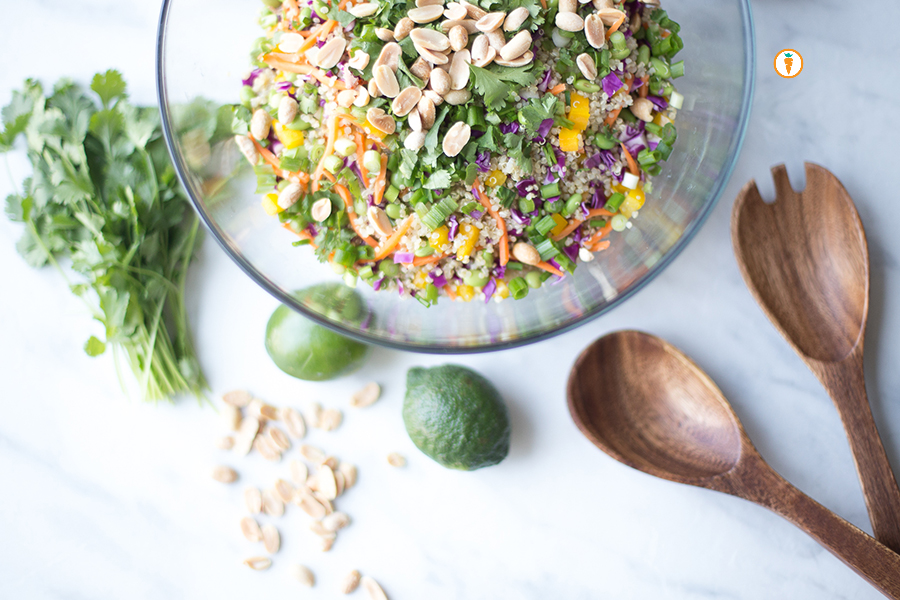 I love quinoa. But I’m really not a fan of it by itself. Are you? My preference is to enjoy it when it’s “mixed” into something like a pesto quinoa salad or as a pilaf with garlic mushrooms. Mmmmm. I’ve been making this version of a Thai quinoa salad for years now but never really took the time to standardize the recipe. With some encouragement from friends and family, I finally did it.
I love quinoa. But I’m really not a fan of it by itself. Are you? My preference is to enjoy it when it’s “mixed” into something like a pesto quinoa salad or as a pilaf with garlic mushrooms. Mmmmm. I’ve been making this version of a Thai quinoa salad for years now but never really took the time to standardize the recipe. With some encouragement from friends and family, I finally did it.
Here are my pre-requisites for a quinoa salad:
I want it to be hearty enough to be a meal, so I need a solid source of protein. Enter the edamame bean! A ½ cup serving of edamame beans is about 12 grams of protein.
I want color. I eat with my eyes so against the quinoa I wanted to see some yellow, red, purple and green. A colorful meal also means I’m feeding my body variety of nutrients.
I want a good-for-you dressing. I’m not fearful of fat and my mantra has always been: it’s not the quantity of fat you eat, it’s the quality. The dressing for this recipe is largely based on peanut butter. Go for a natural PB that isn’t loaded with added fats, sugar or salt. The dressing also has lovely hints of ginger which is great for digestion and amping up the flavor of this salad.
I want it to still be good the next day. C’mon, we all know many salads don’t hold up more than 24 hours. Not this recipe! I prefer to keep the dressing on the side and pour on more as I need it. The quinoa salad itself stays perfectly fine for 3 – 4 days when kept refrigerated in an air-tight container.
This recipe is a hit, no matter where I go. My vegan and vegetarian friends and mama’s all LOVE it. It’s perfect for weekday lunches, as a side or for sharing at a potluck.
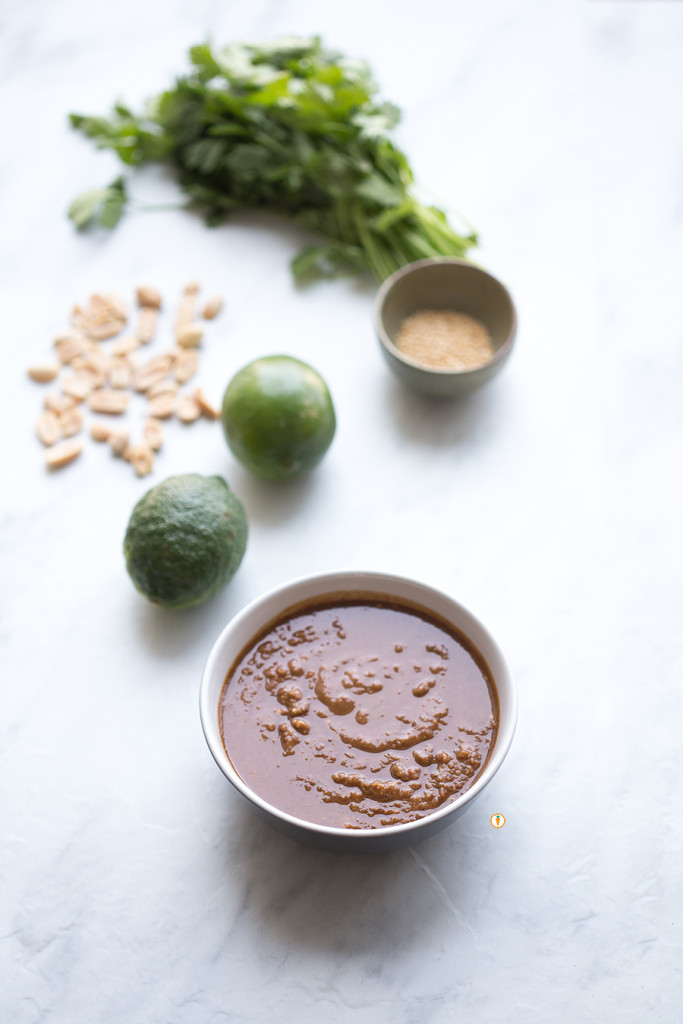
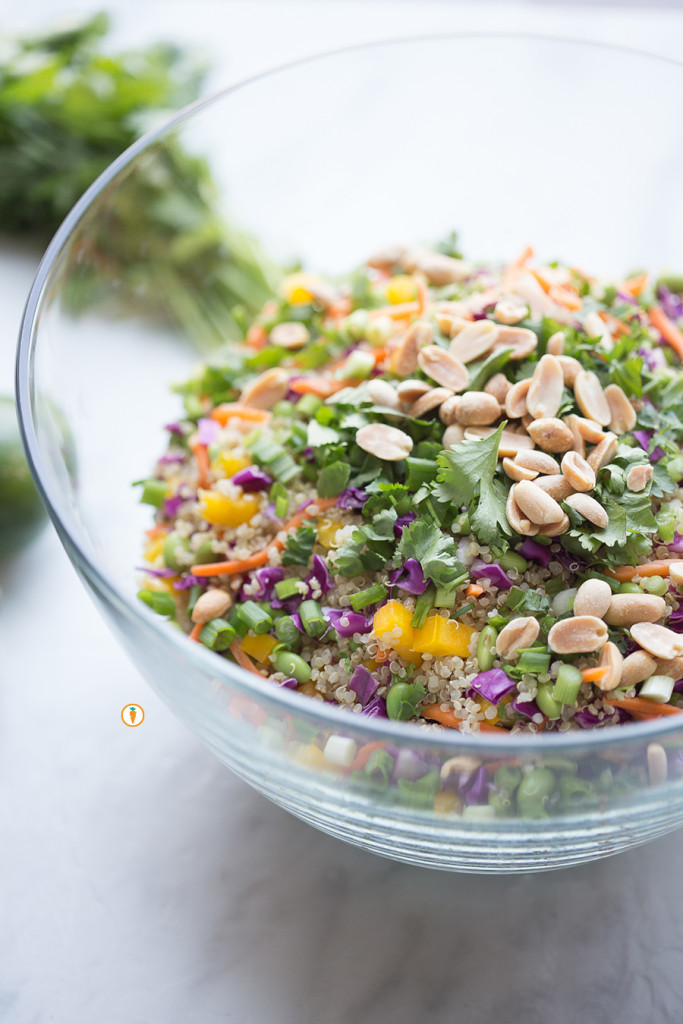
Okay, okay, recipe below!
- Salad:
- 1 cup uncooked quinoa
- 2 cups shredded red cabbage (we like to chop it pretty small)
- 1 red, orange or yellow bell pepper, diced
- 1 cup shredded carrots
- 2 cups edamame beans *steam/cook ahead of time
- ½ cup chopped cilantro
- ½ cup cashews
- 3 green onions, chopped
- For the dressing:
- ⅓ cup natural peanut butter
- 1 tbsp freshly grated ginger
- 3 tablespoons soy sauce
- 1 tablespoon honey (use agave if vegan)
- 3 tablespoons red wine vinegar
- 2 teaspoons sesame oil
- 2 tsp sesame seeds *optional
- juice of one lime
- Prepare quinoa: ensure you've thoroughly rinsed and strained it. Place quinoa in a small pot with 2 cups of water. Bring to a boil and reduce heat to low, cover and simmer until tender and the liquid has been absorbed. About 15 - 20 minutes. Fluff with a fork. Set aside and cool.
- To the quinoa add in cabbage, bell pepper, carrots and edamame beans. Fold this into the the quinoa.
- Prepare the dressing by mixing together all eight ingredients. I often use a handheld blender to do this job but you could totally use your muscles and a strong fork.
- Garnish with cashews, cilantro and green onion. Serve chilled (or eat it up right away).
Food photography done by the talented Ceone Dyck. To learn more about Ceone click here or follow her on Facebook.
Don’t forget to follow Carrots and Cake on Instagram to see tiny square snap shots of my life.
– With Love, Carrots and Cake,

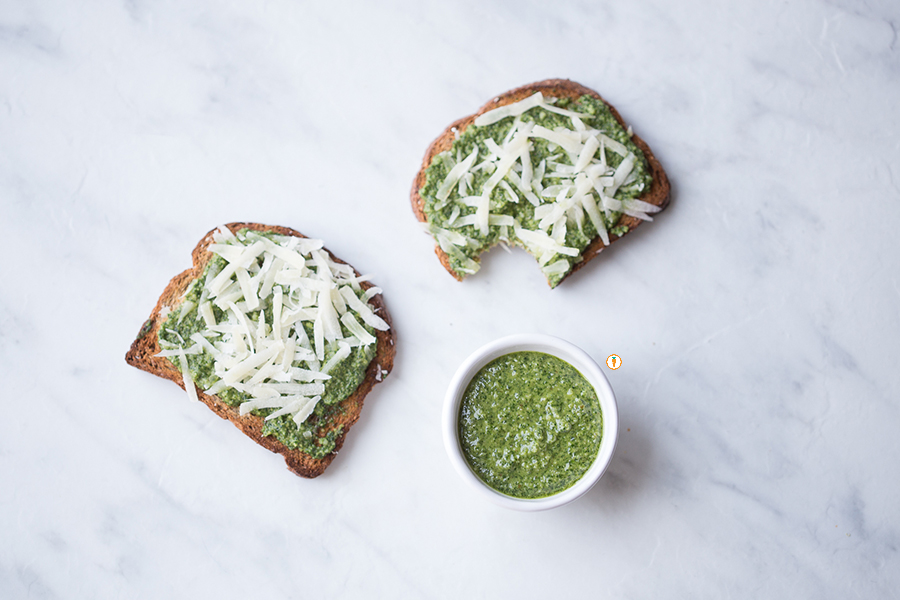 I love me some pesto. Do you? I only began experimenting with this sauce a few years ago and now it’s a pantry staple. Better yet, I’ve even ventured into making my own version of pesto. I was inspired to use kale in this recipe by my summer CSA. We’ve been getting an abundance of kale and I’ve been experimenting with unique ways to use up this nutrient-loaded green.
I love me some pesto. Do you? I only began experimenting with this sauce a few years ago and now it’s a pantry staple. Better yet, I’ve even ventured into making my own version of pesto. I was inspired to use kale in this recipe by my summer CSA. We’ve been getting an abundance of kale and I’ve been experimenting with unique ways to use up this nutrient-loaded green.
Most pesto recipes call for basil. I opted not to use basil primarily because in the fall/winter months it’s actually quite pricey (at least here in Winnipeg) and sometimes I find myself visiting 2 – 3 grocery stores only to not find any! So instead I use parsley. Problem solved.
There’s also a TON of ways you can use up pesto. Here’s a few suggestions to inspire you:
- Use it as marinade for your white fish or chicken
- Place it on top of toast to change up your breakfast game, top with a poached egg
- Toss it in pasta (hot or cold)
- Make pesto spinach muffins
- Use pesto instead of pizza sauce on your crust (my favvv)
- Use pesto for this quinoa salad recipe
- Flavor turkey meatballs with with pesto
- Add small dollops to crostinis and top with cherry tomatoes for a fun appie
- Make a gourmet grilled cheese sandwich with pesto and mozzarella
- Marinade veggies like tomato, zucchini and muchrooms in pesto and grill
Or, eat it by the spoonful
There you have it! Ten ways you can enjoy this pesto!
Why is this pesto a great choice?
- It’s loaded with anti-inflammatory olive oil
- Helps you meet your recommended intake for greens
- Walnuts offer up omega-3, hello heart health!
- There’s cheese in it
- Mic drop, enough said!
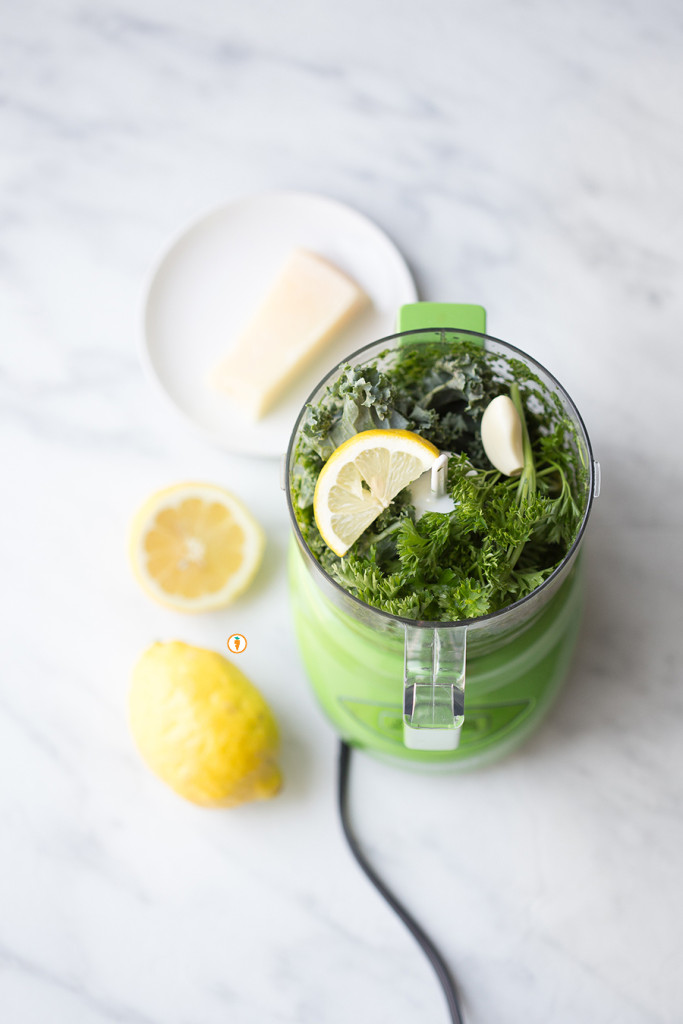
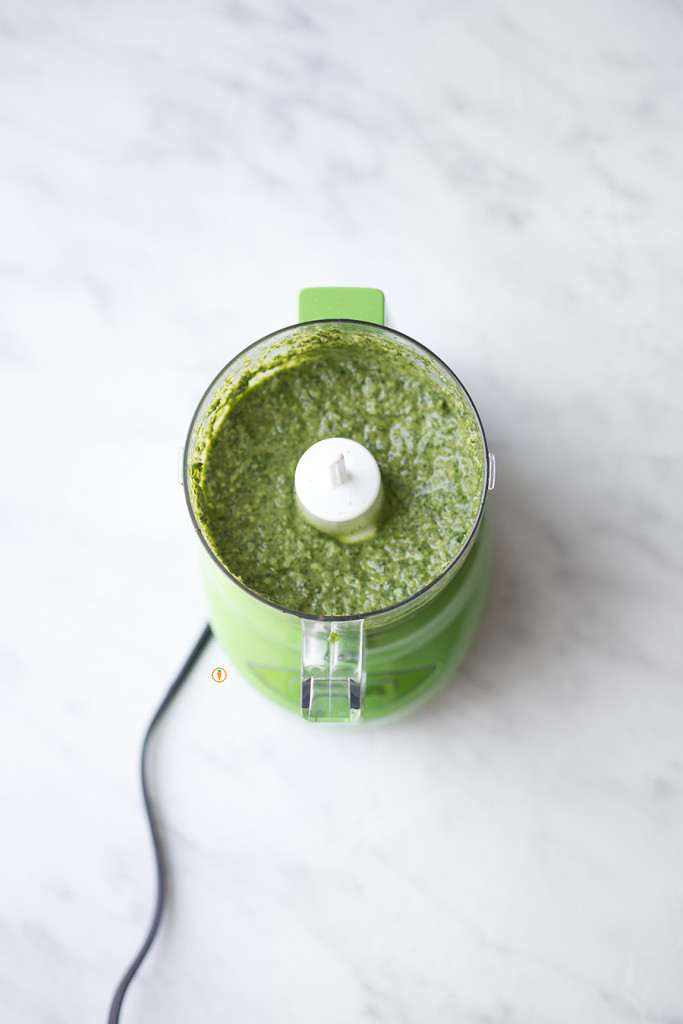
Okay, recipe below.
- ¼ cup walnuts, toasted (or preferred nut)
- 1½ cups torn kale, stem removed
- ½ cup curly parsley, roughly chopped
- ¼ cup cubed or grated parmesan
- ½ cup olive oil
- 1 clove garlic
- juice of one lemon
- To toast walnuts, warm a non-stick skillet over medium heat. Add walnuts and lightly toast for about 8 - 10 minutes or until fragrant. Be careful! You don't want them to burn.
- In a small food processor of blender add walnuts and remaining ingredients. Blend well.
- Taste. Add salt, pepper or more lemon juice as needed. If you find your pesto too runny, you can add another ¼ cup of walnuts.
- Store in an air tight container in the fridge for up to one week or freeze!.
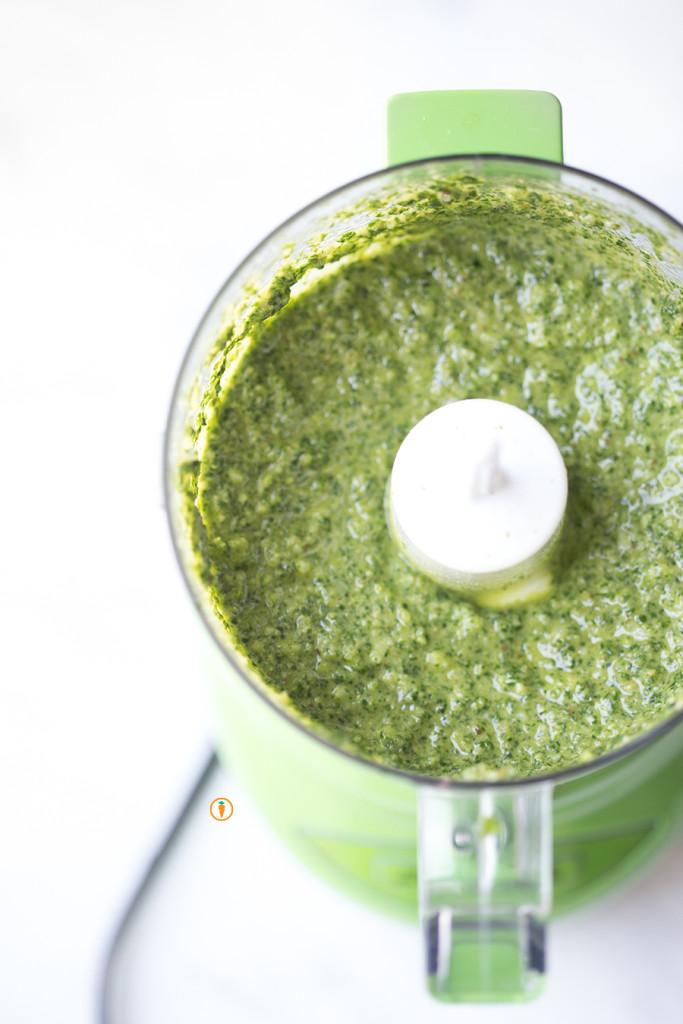 Food photography done by the talented Ceone Dyck. To learn more about Ceone click here or follow her on Facebook.
Food photography done by the talented Ceone Dyck. To learn more about Ceone click here or follow her on Facebook.
Don’t forget to follow Carrots and Cake on Instagram to see tiny square snap shots of my life.
– With Love, Carrots and Cake,

]]>
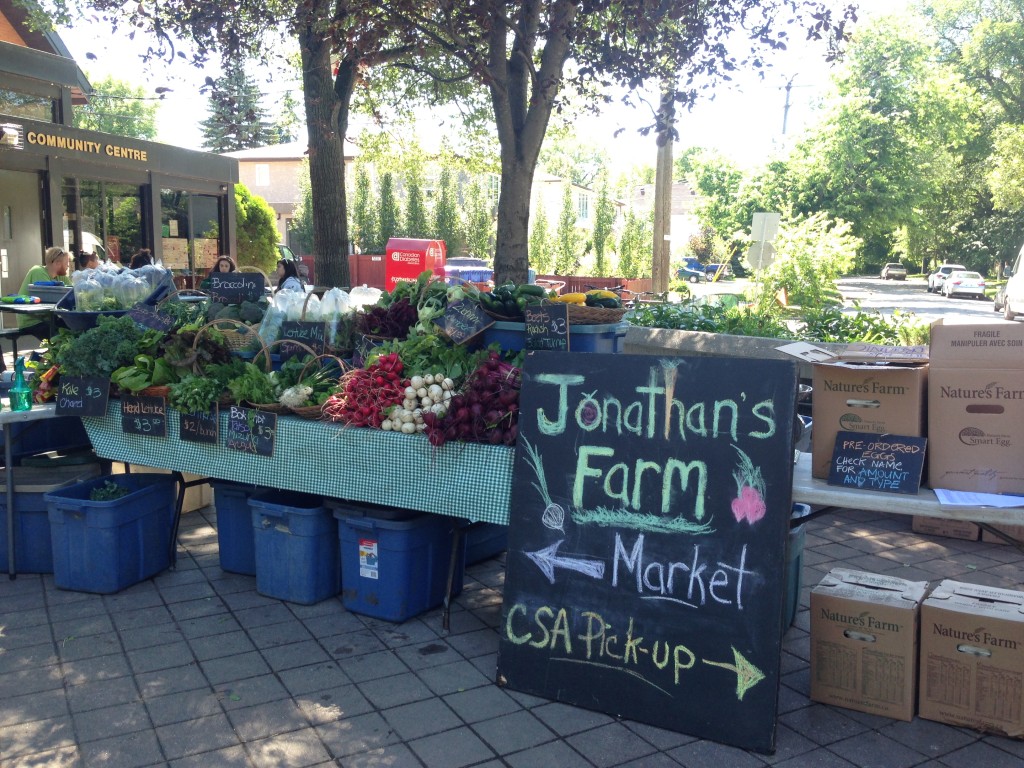
My weekly pick-up stop!
WORD OF THE DAY: lo·ca·vore
Ever heard of the word locavore? A dictionary will tell you that it’s used to describe a person interested in eating food that is locally produced and not moved long distances to market. One common – but not universal – definition of “local” food is food grown within 100 miles (160 km) of its point of purchase or consumption.
So what is CSA and what does it have to do with locavores?
CSA.. Hmm what does that stand for? Maybe you have an idea. It’s something about a farmer sending you a box of fresh veggies right? Oh maaaybe it stands for Canadian Shared Agriculture?! Close, but not quite. Turns out it stands for Community Supported Agriculture and it’s an internationally recognized concept! I’ve been quite curious about the whole scene for some time now but I am finally making a commitment and getting involved! Here’s my story on how it all went down:
Phase 1: Do the research
There is a ton of great information on CSAManitoba.org
CSA Manitoba recommends you ask a couple of key questions before you sign up. Here are a few that I wouldn’t have thought of myself;
- Do you provide recipes for less common produce? Some provide a weekly newsletter and recipes to help you make use of those veggies you may not have come across before (like, kohlrabi!)!
- Is the payment in full or split?
- May I visit the farm during the season?
The website has a very good FAQ page for other questions as well. I browsed the entire website and after a solid look I came to some conclusions.
Pros of a CSA box:
- It’s like a subscription to fruit and vegetables. That is sure to make you way healthier than Cosmo.
- Meeting farmers! Farmer’s feed the world, I’m sure they make great friends.
- The produce is usually picked the same day you receive it! This is a huge advantage as much of the produce we get in Canada travels far and wide. When fruits and vegetables have to travel from Florida, California or Mexico they are picked under-ripe so that by the time they reach our grocery stores they are perfectly ripe. Makes enough sense but that means that the produce is ripening in a dark cool crate instead of being in the sun, attached to plant where it can continue to receive nutrients.
- Strengthening the local economy. After all, you decide with your dollar.
- I’m also looking forward to being challenged by new produce, which I would most likely avoid in the store. Maybe I’ll get a fennel…or is it just fennel? What’s two fennel? Fennels? Feni?!
Cons of a CSA box:
- I can’t see any yet, I’ll keep you posted once the goods start rolling in.
Phase 2: Chose a farm.
CSAManitoba.org is also your go-to for this step.
Out of the 23 farms listed who offer the CSA program I decided on Jonathan’s Farm. Not only did I choose them because the drop off point is very close to my home but also because they farm according to organic standards and aim for sustainable Earth friendly agriculture. Now, I’m not 100% adamant on organic all the time, because I doe have bills to pay. But if I can grab a big box of organic veggies bi-weekly then I am not complaining. Plus Jonathan is an incredibly personable name so I already know he is a good guy.
Here are a couple of things that happen on Jonathan’s farm which contribute to sustainability of the land;
- Cover cropping; No, not like a green house where you cover up the crops, also not a crop blanket made by the crop’s grandma. Cover cropping is when the crops act as a blanket for the land. Which keeps the top soil from blowing away and wasting nutrients.
- Nutrient monitoring; A soil test which determines the amount of minerals and nutrients in the soil and allows the farmer to determine how to best supplement their fields.
- Crop rotation; Planting different crops on the same land each season. Different crops give and take different minerals from the soil. Changing from potatoes to wheat or barley to canola allows the earth to essentially be recycled over and over instead of depleted.
Okay, I think I’ve shared what I wanted for now. If this has peaked your interest, you can always visit Jonathan at the Wolsley Farmers’ Market on Tuesday’s from 3:30pm to 7:00pm at 980 Palmerston Ave. Stay tuned for a follow up post on my experience with my first CSA box this summer. Can’t wait!
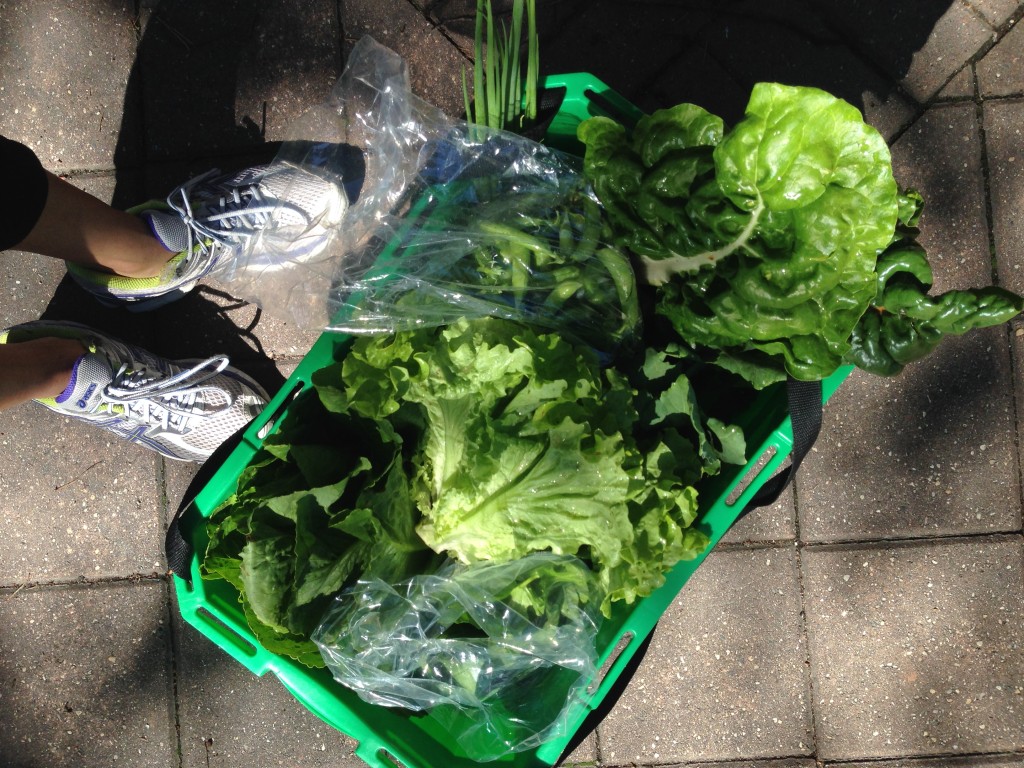
My loot from a few weeks ago: green leaf lettuce, romaine lettuce, peas, spinach, swiss chard, turnips, scallions, radishes, basil + more!
Please note the content of this post was written by 4th year Human Nutritional Sciences student Johanna Adriaansen. Johanna also maintains her own website and is an aspiring Dietitian!
Don’t forget to follow Carrots and Cake on Instagram to see tiny square snap shots of my life.
– With Love, Carrots and Cake,

]]>

Maybe I’m pretending to smile. Or maybe I’m not.  Photo credit: Bree-Ann Merritt Photography
Photo credit: Bree-Ann Merritt Photography
It’s that time of year: the sun is shining, birds are singing, winter jackets are swapped for tank-tops, and parks are filled with ambitious vitamin D deprived Manitobans intent on soaking up every single bit of fresh summer air they can. It’s the absolute best time for outdoor workouts, trips to the zoo, or a hike with friends! But before you grab your runners, rollerblades, or dumbbells, let’s talk about how you can fuel your body to get the most out of your physical activity.
What should I eat before my activity?
The best way to ensure that you’ll be properly fueled for your next sweat session is to eat balanced meals from all four food groups every 3 – 4 hours beginning with a protein and fiber-rich breakfast (like a delicious bowl of overnight oats…see photo below *drool*).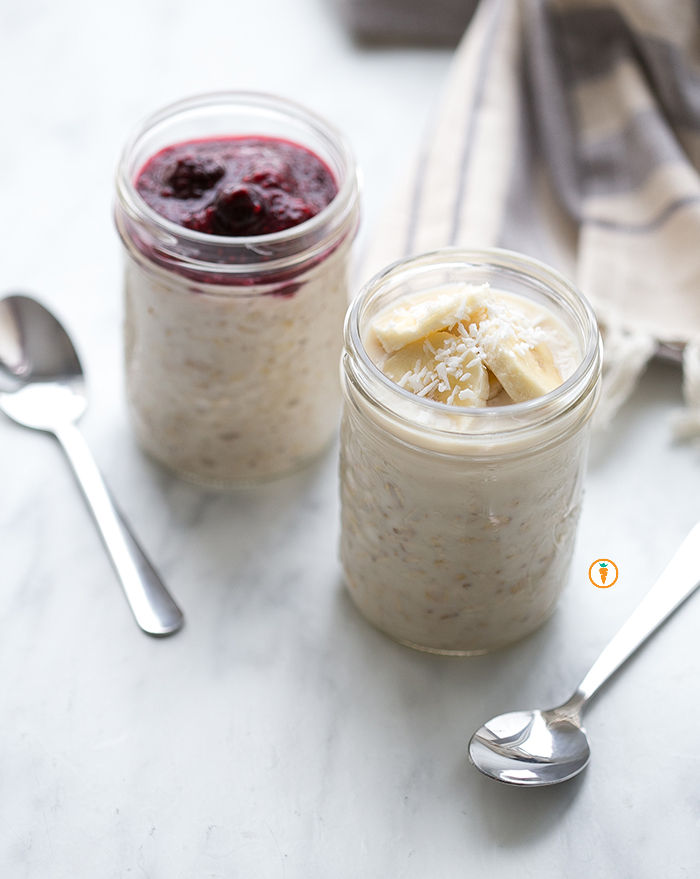
What you choose to eat should ideally be determined by the timing of your workout. For example, if you had a meal at 1:00pm and plan to work out at 3:00pm, there may not be a need for a snack. If there is a longer gap you could consider the following:
2-3 hours prior to exercising, eat something that is sort of like a small meal, aiming for three food groups, and going easy on the fibre and fat (both are known to slow down digestion):
- Chicken breast, cucumbers with sweet potato
- Bowl of cereal with a small handful of pumpkin seeds and skim milk
- A large salad with legumes (chickpeas, beans, lentils) and quinoa
½ – 1 hour prior to exercising, focus primarily on carbohydrates – these foods are less likely to cause discomfort during your gym sesh and will give you some quick energy:
- Yogurt
- A medium banana
- Unsweetened applesauce
- Rice cakes
What should I eat after my activity?
We offered you up some suggestions to improve your pre-workout eats. And now, we want to share tips and tricks to ensure your post-workout meal is on point. Why do we care? Because, it’s important to refuel tired muscles. Much like your pre-workout snack, a blend of protein (approximately 15 – 25 grams) and carbohydrates will be the perfect combination to aid in the recovery process along with a ton of water. Protein is essential in building and maintaining muscle and supporting muscle recovery after exercise. Research tells us that ingesting protein shortly after intense exercise can help build muscle and repair muscle damage. And of course, water is important to replace what you may have lost via sweat and prevent dehydration.
Similar to your pre-workout nutrition, timing is just as important for post-workout meals. You’ve got about a one-hour window to replenish your body and offer it some fuel. For most folks who exercise in the evening, a balanced dinner after activity may be sufficient. But if you just need something to tie you over before your next meal consider munching on:
- A handful of power trail mix (pumpkin seeds, almonds, walnuts, and dried blueberries and goji berries) with Greek yogurt
- 1 – 2 slices of sprouted wheat toast with a natural nut butter and a glass of milk
- A few energy date balls with a glass of milk
- ¾ cup edamame beans with a light olive oil dressing
- Egg salad filing on top of a pice of toast
- 1 serving of whey isolate within a fruit smoothie
Like what you see on this list above? Learn more about pre- and post-workout nutrition here. And oh! There are some recipe suggestions too – you know I’m a suck for recipes!
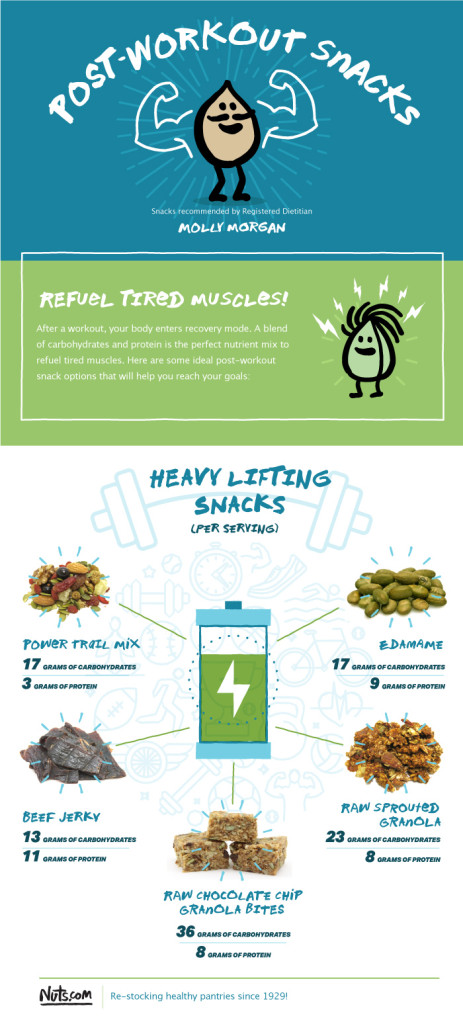
If you want to brush up on what your personal exercise nutrition should or could look like, contact a Registered Dietitian. We’re the trusted source for nutrition information. If you have a specific training need, let me know and I can connect you to a reputable colleague who knows the ins and outs of exercise nutrition!
Food photography and blog post written/captured by a talented student volunteer, Ceone Dyck. Ceone is a graduate of Human Nutritional Sciences. To learn more about Ceone click here or follow her on Facebook.
Please note this is not a sponsored post.
Don’t forget to follow Carrots and Cake on Instagram to see tiny square snap shots of my life.
– With Love, Carrots and Cake,

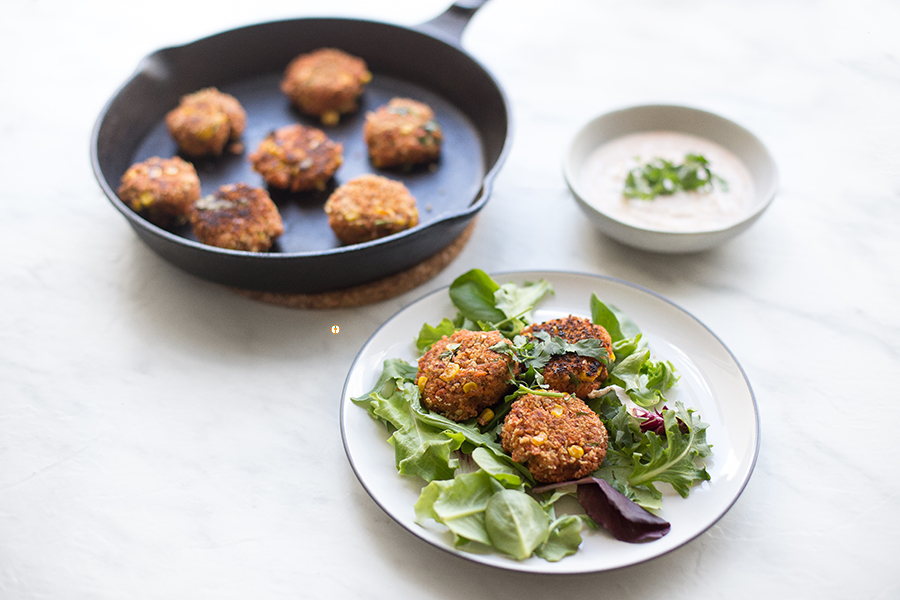 Hayyyyy friends. I’ve got another recipe to share with you today, this time, I wanted to focus on creating something that was budget friendly and easy to make. The result, tandoor spiced salmon cakes. The major protein in this recipe comes canned salmon which can typically range from $2.50 – $3.50 (Cdn) per can. A pretty sweet deal if you ask me!
Hayyyyy friends. I’ve got another recipe to share with you today, this time, I wanted to focus on creating something that was budget friendly and easy to make. The result, tandoor spiced salmon cakes. The major protein in this recipe comes canned salmon which can typically range from $2.50 – $3.50 (Cdn) per can. A pretty sweet deal if you ask me!
In our home, I’m the only fish eater. The hubs has made it loud and clear that he’s “allergic” (ahem, liar) to any form of seafood. Because of this, I tend not to splurge on seafood and often settle for canned varieties in single servings to help me meet my 2 servings of fish per week. Salmon also has a number of health benefits, here are only a few:
- it’s loaded with heart healthy omega-3 fatty acids
- excellent source of calcium (from the bones)
- it’s also one of the few foods that offer up vitamin D
- it’s super anti-inflammatory and therefore helps to protect the health of all the tiny cells that make up your body
The inspiration for these salmon cakes came from the Food Network. I knew immediately I wanted to add an Indian flair to their version so I set out for some Patak’s Tandoori Paste. This popular paste can be found at most grocery store retailers in the ethnic food aisle. A little bit of this paste goes a long way! I also added my favorite spices: garam masala, coriander and ground cumin.
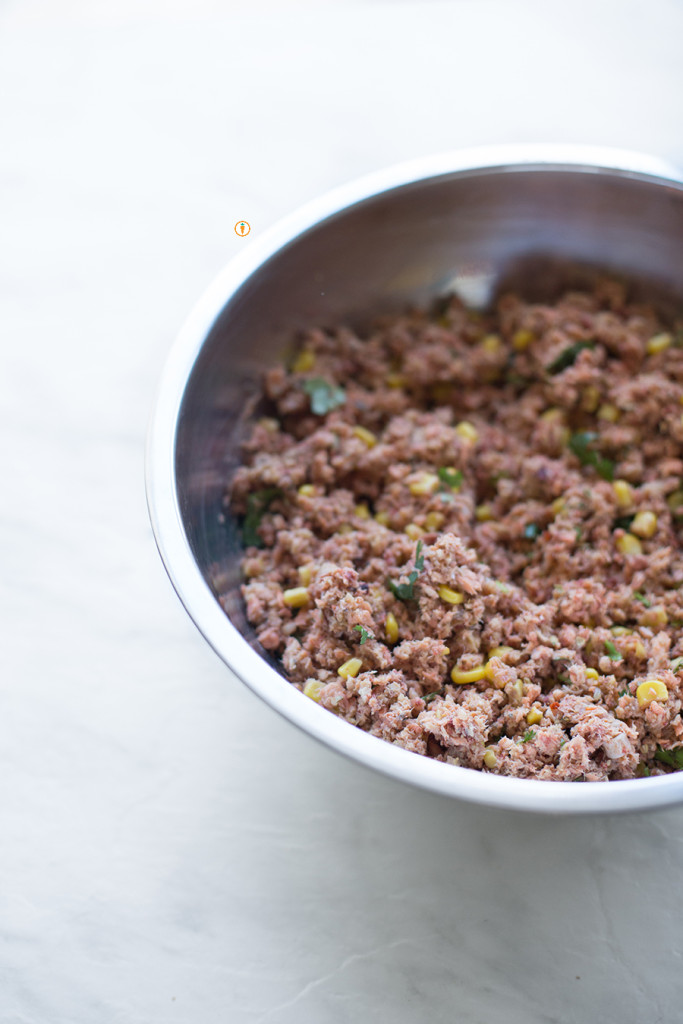
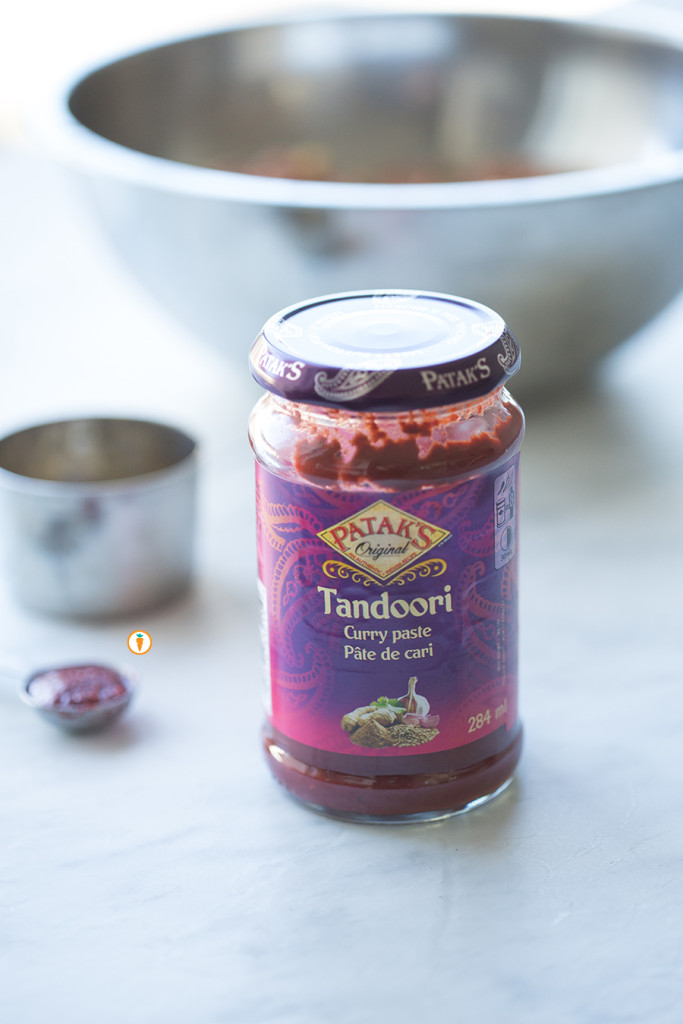
CAUTION: we learned a lot while developing this recipe. Keep these two pieces of advice in mind:
- DO NOT use the food processor, blender or beaters to create the mixture. Let me tell you, that’s a recipe for an epic fail!
- Make sure you thoroughly drain the liquid from the salmon cakes.
- 3 7.5 oz cans salmon, drained
- 1 cup frozen corn, thawed or canned corn
- 1 large egg
- ½ cup panko bread crumbs + ¼ cup panko bread crumbs in a shallow plate
- 2 Tbsp tandoori paste
- ¼ cup fresh cilantro, chopped
- 1 tsp ground cumin
- 1 tsp garam masala
- 1 tsp ground coriander
- Pinch of ground black pepper
- 3 Tbsp extra-virgin olive oil
- Place all ingredients (first ten) into a bowl. Mix together using a fork until all ingredients are combined.
- Shape into 2" or 3" patties and then press salmon cakes into the breadcrumbs, coating both sides well.
- Heat the olive oil in a large oven-safe nonstick skillet or cast iron pan over medium heat. Add the salmon cakes and cook until golden brown, 3 to 4 minutes per side.
- Transfer the skillet to the oven and bake until the cakes are heated through. About 5 - 8 minutes more.
Feel free to garnish your salmon cakes with some plain yogurt that has been spiced with salt, black pepper and some chilli powder. And of course, garnish with more fresh cilantro. These salmon cakes are great on a bed of greens, over a naan and I’ve also enjoyed gobbling it up solo.
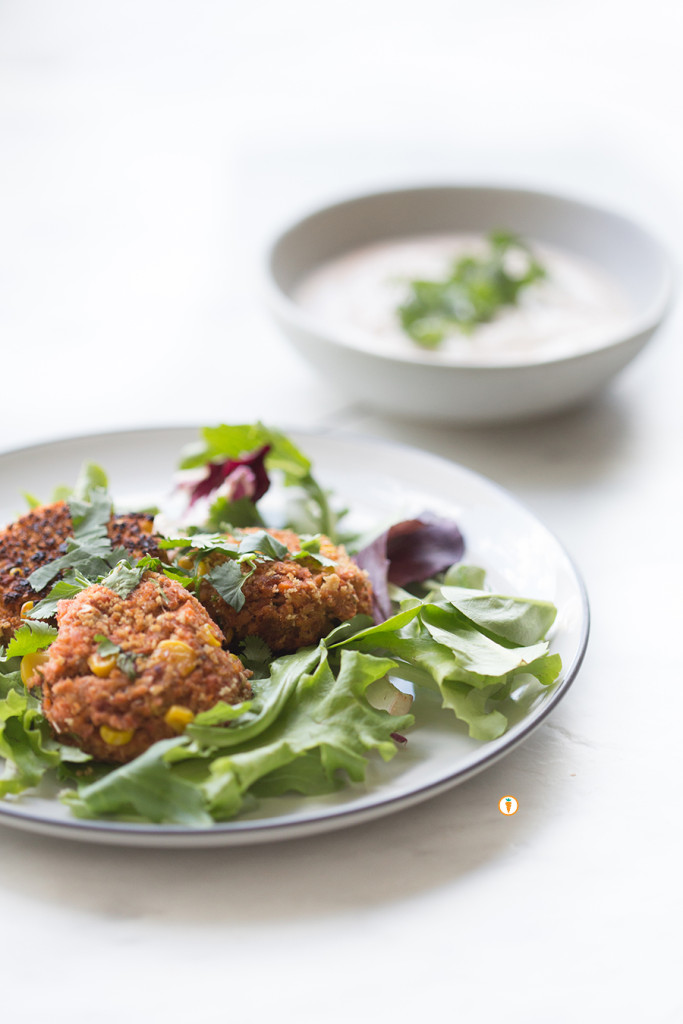
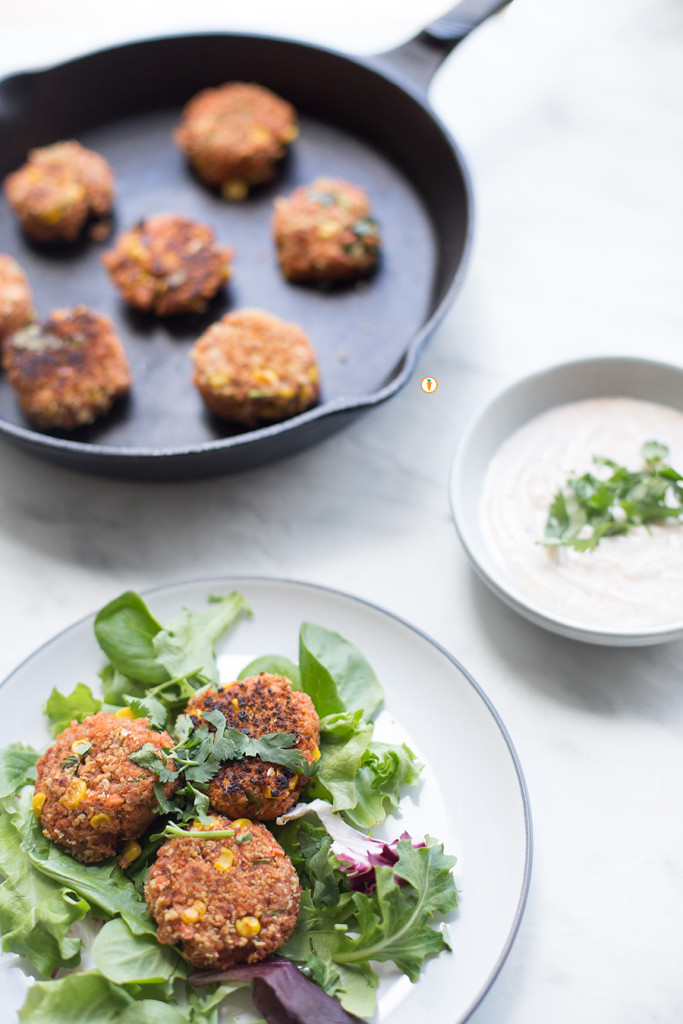 Food photography done by the talented Ceone Dyck. To learn more about Ceone click here or follow her on Facebook.
Food photography done by the talented Ceone Dyck. To learn more about Ceone click here or follow her on Facebook.
Don’t forget to follow Carrots and Cake on Instagram to see tiny square snap shots of my life.
– With Love, Carrots and Cake,

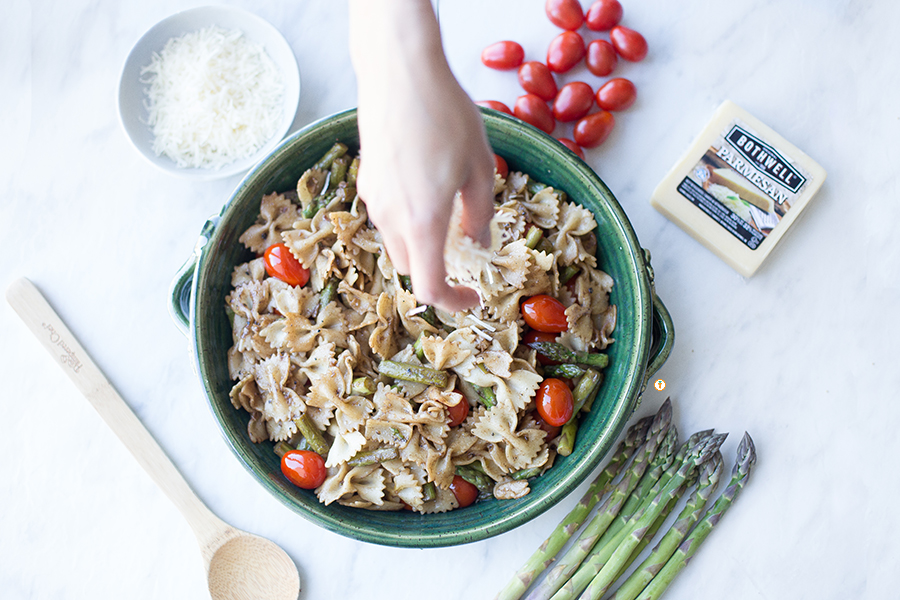 YAASSSS. Asparagus is finally in season. I remember being in my twenties and trying a spear of asparagus for the first time. I was confused. But then I had another spear. I was hooked. Since then, I’ve enjoy asparagus in many ways from grilling, steaming, wrapped in prosciutto and mixed into a summery pasta dish!
YAASSSS. Asparagus is finally in season. I remember being in my twenties and trying a spear of asparagus for the first time. I was confused. But then I had another spear. I was hooked. Since then, I’ve enjoy asparagus in many ways from grilling, steaming, wrapped in prosciutto and mixed into a summery pasta dish!
This pasta recipe is SO EASY to throw together on a busy weeknight. Washing and trimming the asparagus ahead of time will help make this a total breeze. Besides, doesn’t everyone love pasta?
Here are a few reasons why you’ll enjoy this recipe and feel good about eating it:
- It’s colourful – beautiful red and green colors make this pretty on the eye
- The whole wheat pasta will keep you full
- You can top your pasta with any cheese you desire, I used Bothwell Cheese Parmesan but it’s also taste with goat cheese and feta cheese; if you’re vegan you can nix the cheese or use your favorite dairy-free product!
- It includes 9 only ingredients! NINE!
- The olive oil is super heart health and anti-inflammatory (remember, we talked about that here)
Kay…one more picture, and then I’ll share the recipe!
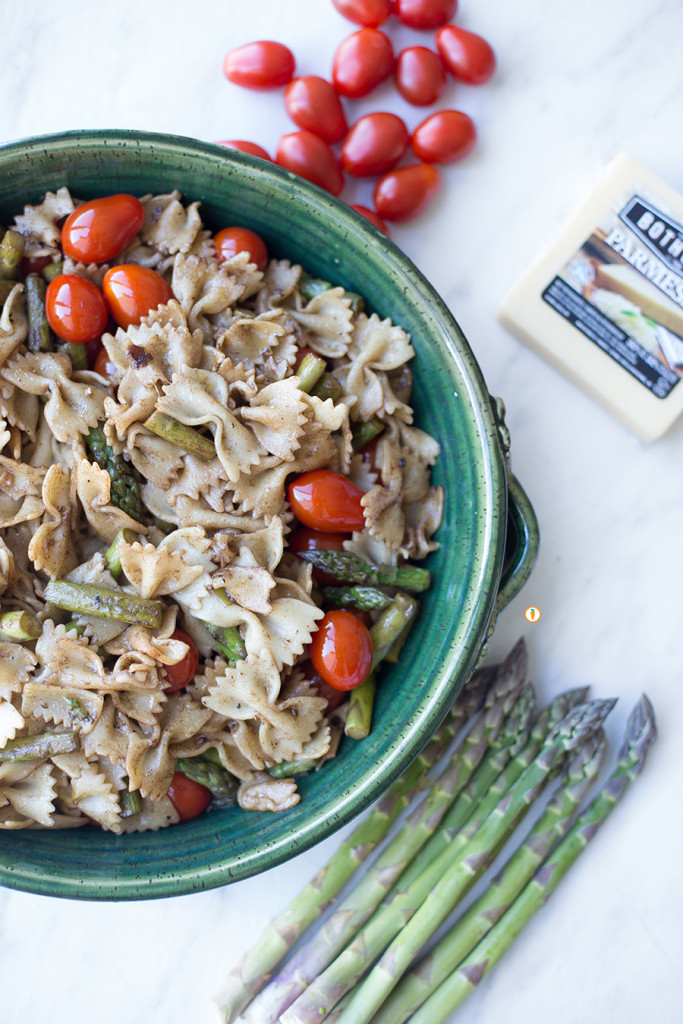
- 2 cups whole wheat pasta (uncooked)
- approx 20 spears of asparagus, washed, trimmed and cut into 1 inch pieces
- 1 cup cherry tomatoes, halved
- 2 cloves garlic
- ¼ cup and 1 tbsp olive oil
- ¼ cup balsamic vinegar
- Salt and pepper, to taste
- ⅓ cup cheese (parmesan, goat cheese or feta cheese)
- Cook pasta according to package directions. Drain and set aside.
- Meanwhile, sauté asparagus in 1 tbsp olive oil over medium heat. Continue to cook asparagus until it is tender.
- Add in garlic, cooked pasta, remaining olive oil, balsamic vinegar, salt and pepper. Mix together and heat through for about one minute to allow the garlic to infuse itself into the dish.
- Add in cherry tomatoes and continue to heat the pasta through for 5 minutes or until cherry tomatoes begin to wilt.
- Remove from heat. Top with cheese.
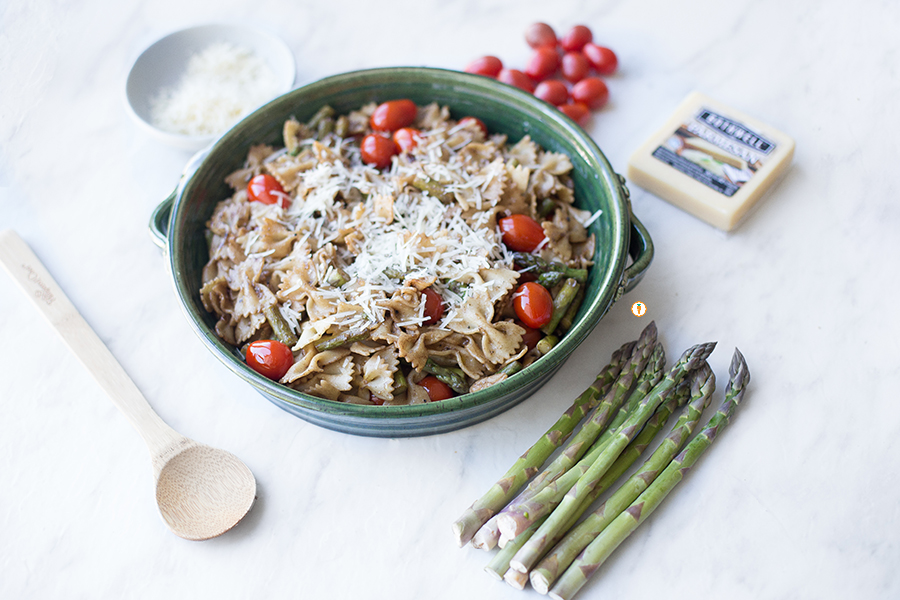 Food photography done by the talented Ceone Dyck. To learn more about Ceone click here or follow her on Facebook.
Food photography done by the talented Ceone Dyck. To learn more about Ceone click here or follow her on Facebook.
Don’t forget to follow Carrots and Cake on Instagram to see tiny square snap shots of my life.
– With Love, Carrots and Cake,

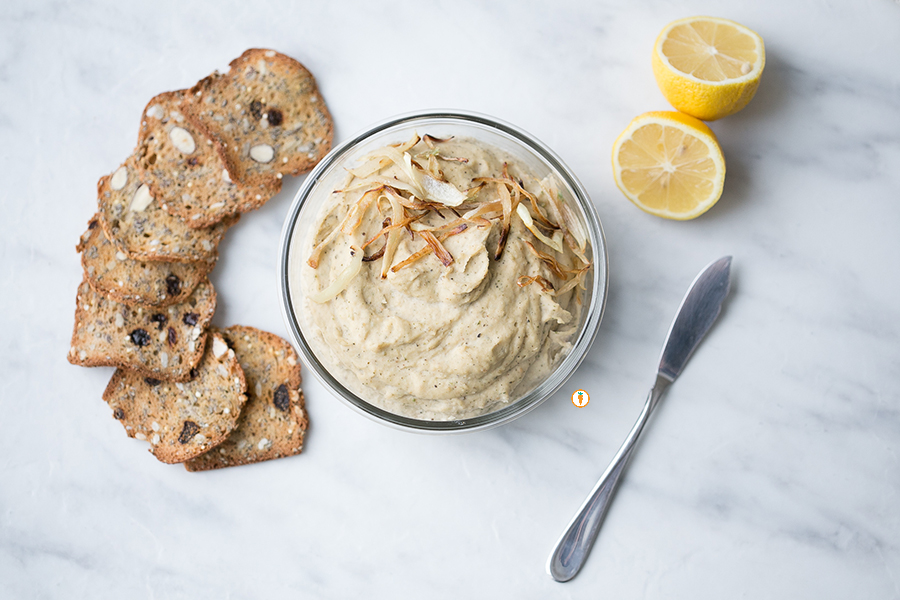 I didn’t think I would say it. But I am. Sometimes, I get sick of hummus.
I didn’t think I would say it. But I am. Sometimes, I get sick of hummus.
haaawwwww
Okay chill–we all need variety. After all, variety is the spice of life! So what is a Dietitian and foodie to do? Improvise! I always seem to have a can white kidney beans (or cannellini beans) in my pantry so I opted to use this as inspiration to create a protein based dip. Because the cannellini bean is more pastey the result is a thick and spreadable dip. I prefer to dunk veggies and crackers into this pretty stuff but I’ve also added dollops of it onto salads.
This recipe is totally versatile. You can add more or less of any ingredient or even nix something you don’t like. For example, my sister isn’t the biggest fan of caramelized onions, but I love them. They make for a beautiful garnish and give it a sweet flavour. Love! Give it a try and let us know what you think!
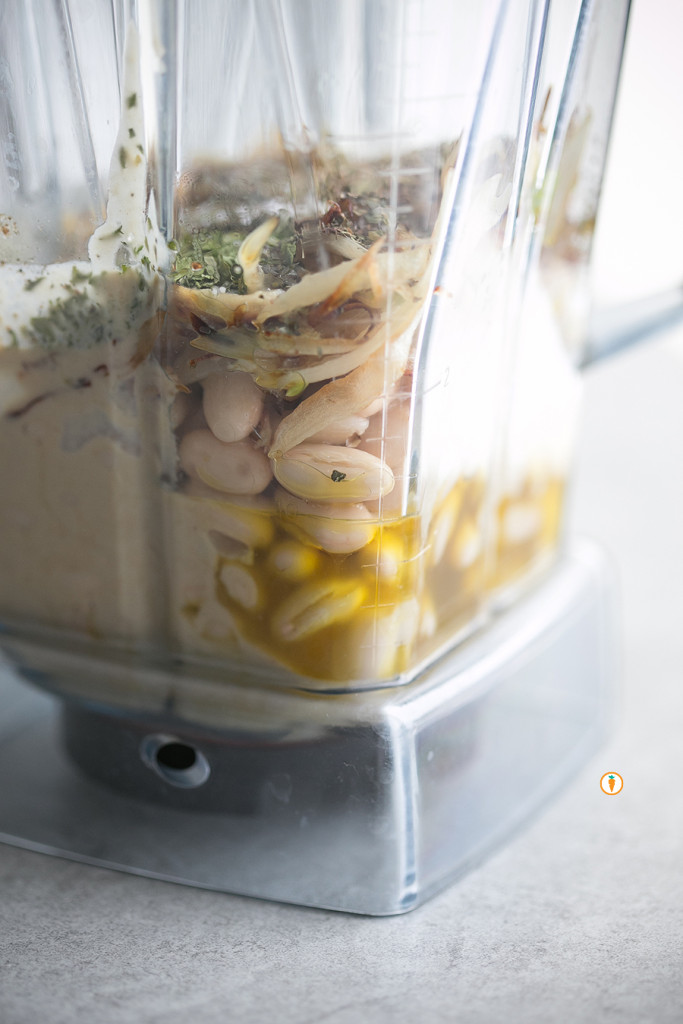
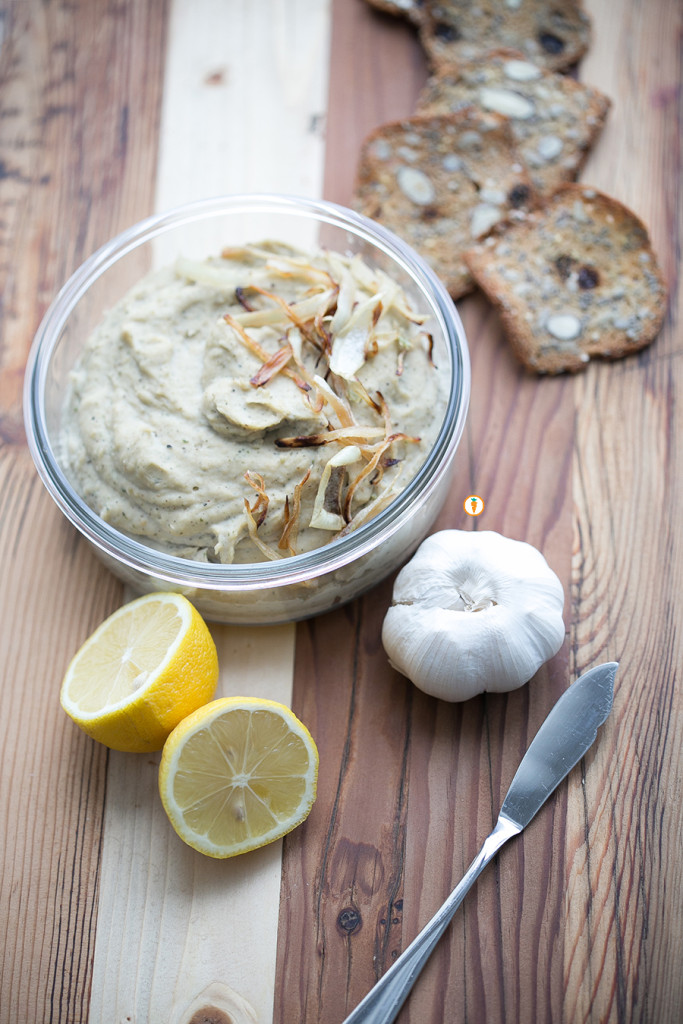
- 1 19oz can white kidney beans, rinsed
- 3 - 4 cloves garlic, roasted in oven
- ⅓ cup tahini
- ¼ cup olive oil
- Juice of one lemon
- 1 tsp dried parsley
- 1 tsp dried basil
- 1 tsp dried oregano
- 1 tsp salt
- 1 tsp black pepper
- Place all ingredients into a food processor or blender.
- Blend until smooth.
- Taste and add more spices as needed. Feel to also add 1 tbsp of water at a time to reach a desired consistency.
- Garnish as you wish! You can garnish with caramelized onions, olives, herbs or a drizzle of olive oil!
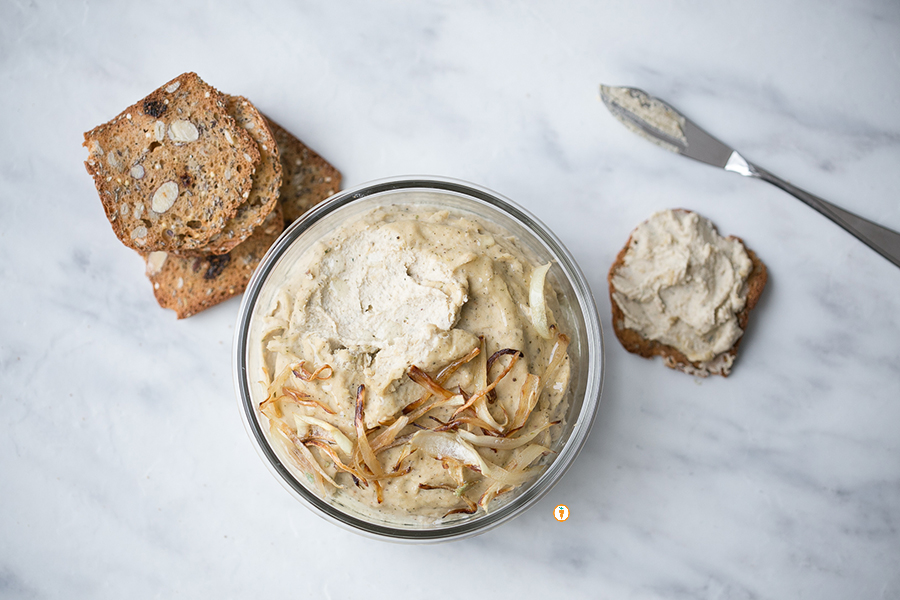 Food photography done by the talented Ceone Dyck. To learn more about Ceone click here or follow her on Facebook.
Food photography done by the talented Ceone Dyck. To learn more about Ceone click here or follow her on Facebook.
Don’t forget to follow Carrots and Cake on Instagram to see tiny square snap shots of my life.
– With Love, Carrots and Cake,

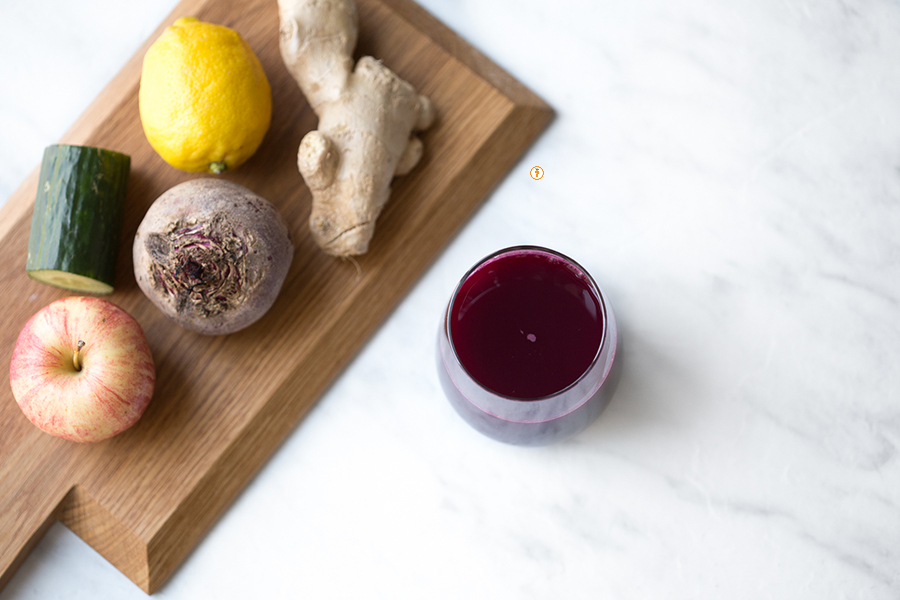
p.s. recipe for this super awesome juice is coming your way (and you don’t need a juicer)
We’ve heard of these magical food properties called anti-inflammatory agents, but what are they? Answer: when our cells excrete waste it is sometimes in the form of oxidative waste, which can be toxic and harmful to the body. These waste particles are like little fists that can punch the cells and tissues, causing inflammation. Kinda like when you scrape your elbow or get a deep paper cut, the area around the injury becomes reddened and inflamed. That’s a good thing, because your body is healing. BUT there is also a type of inflammation that can happen at a cellular level and is referred to chronic low-grade inflammation.
Why does inflammation happen? And what’s the big deal?
Inflammation can take place when we bombard our body with things like sugar, refined grains, stress, environmental toxins, aging etc. There’s a lot we’re still learning about low-grade inflammation. The reason why we’re concerned is because this very type of inflammation is linked to heart disease, metabolic syndrome, type 2 diabetes, cancer, rheumatoid arthritis, and neurological degeneration.
But here’s the cool news….
Anti-inflammatory agents come in like the heroes that they are and swiftly carry away those feisty little guys to ensure that nothing is being irritated and swollen inside the body. Anti-inflammatory is goooood news! Even better news is that we can find it in all sorts of foods!
Here are JUST three anti-inflammatory foods you ought to be eating, and all just in time for the upcoming harvest season.
ONE.
Beets – the deep red/purple color of beets indicates a lot of functional health properties. Anti-inflammation included! Boil, pickle, roast, juice, whatever! Just get these beautiful root plants into your diet and let your digestive system reap the benefits.
TWO.
Turmeric – let’s not forget that herbs and spices have endless medicinal properties. Turmeric is a root plant that is often dried and ground into a lovely yellow spice. The flavor is subtle, a bit pungent but also warm and peppery. It’s commonly used for mustard and curry dishes but the options are endless. Add to scrambled eggs at breakfast, rice for a hint of flavor or soups to bring even more warmth. Or hey, how about making this Kaju Korma over some baked tofu cubes?
THREE.
Olive Oil – Those Mediterranean folk, famous for their lack of inflammatory disease and in part due to their high fat diet. High fat?! Crazy right? The thing is that they are eating some majorly clean, healthy fats over in Greece such as fatty fish, olives and oils.
When fishing for the anti-inflammatory properties of cooking oils (ha, fishing) we have to make sure we grab Extra Virgin Olive Oil or Cold-Pressed Olive Oil, the cold-pressing form of processing keeps all their health benefits in tact. Limit the EVOO to your salads or for bread dipping because high temperatures will destroy those anti-inflammatory agents before they can even get to your cells…dangit. But feel free to use canola oil which is also rich in omega-3 fatty acids in your frying pan or the oven.
Now, here’s a wild idea to tie it all together…toss your chopped beets in some olive oil, sprinkle with turmeric and any other spices of your choice and roast for 25 minutes at 425F. Voila! A beautiful, fall-harvest, anti-inflammatory dish!
If you want to learn more about this specific diet, get your hands on Desiree Nielsen’s book Un-Junk Your Diet: How to Shop, Cook, and Eat to Fight Inflammation and Feel better Forever.
If you’re interested in eating more in the way of an anti-inflammatory diet, contact me. I’d love to help!
Please note the content of this post was written by 4th year Human Nutritional Sciences student Johanna Adriaansen. Johanna also maintains her own website and is an aspiring Dietitian!
Don’t forget to follow Carrots and Cake on Instagram to see tiny square snap shots of my life.
– With Love, Carrots and Cake,

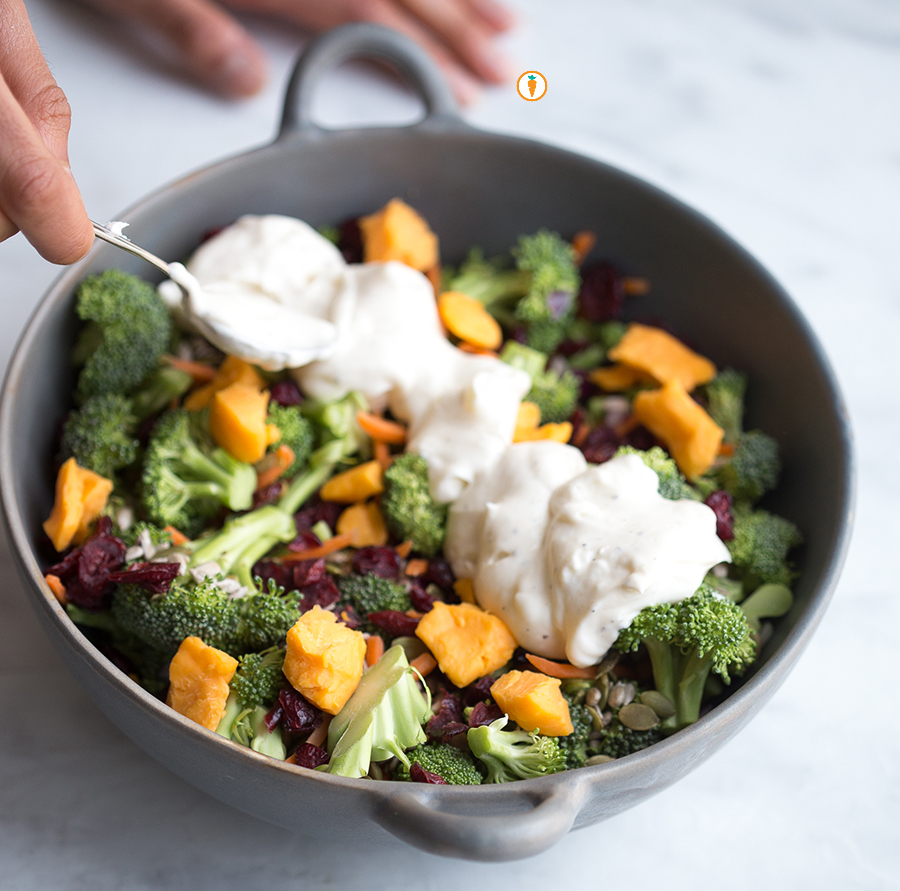 As per the title of this blog post, the feature vegetable in this summer salad is none other than the broccoli. Growing up we typically only enjoyed broccoli when it was cooked into saag which is a giant mush (I’m not joking) of cooked down onion, spinach, broccoli and an array of spices. Now, I have fun using broccoli in stir fry’s, roasted, dunked into a ranch dip and of course, all dressed up in a Greek yogurt dressing.
As per the title of this blog post, the feature vegetable in this summer salad is none other than the broccoli. Growing up we typically only enjoyed broccoli when it was cooked into saag which is a giant mush (I’m not joking) of cooked down onion, spinach, broccoli and an array of spices. Now, I have fun using broccoli in stir fry’s, roasted, dunked into a ranch dip and of course, all dressed up in a Greek yogurt dressing.
I’m sure you’ve tried a few versions of this recipe. But I really think you should make my recipe your go-to for summer potlucks, dinners or even enjoy this salad as a snack. Along with broccoli, this salad also includes a juicy apple, red onion, carrot sticks, cranberry and pumpkin seeds. Feel free to swap out ingredients and change the quantities as you wish. The “OG” version of recipe usually calls for copious amounts of mayo and sometime bacon. THIS version is laced with a high protein dressing courtesy of Greek yogurt.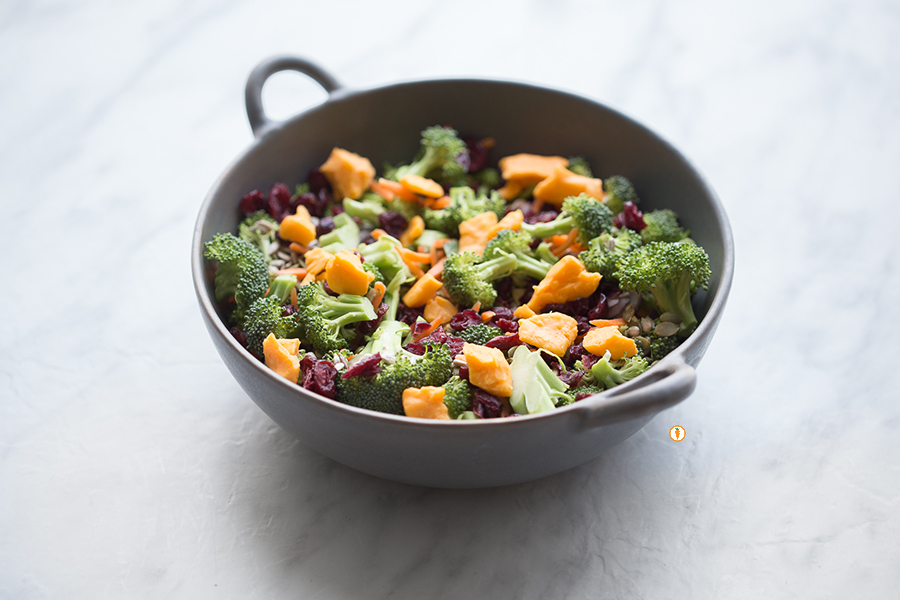
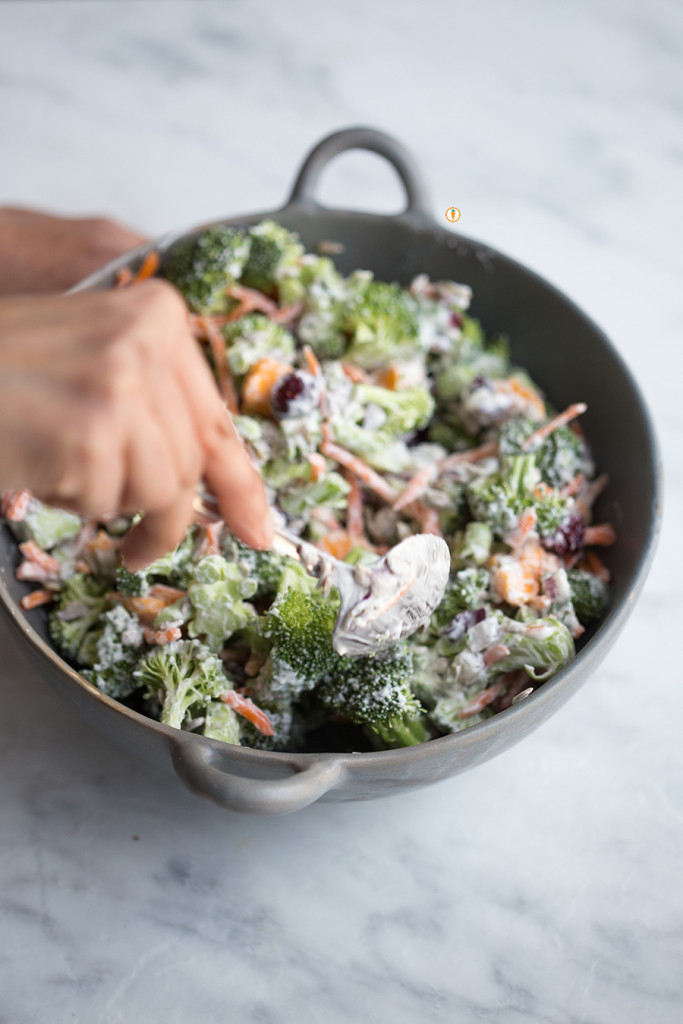
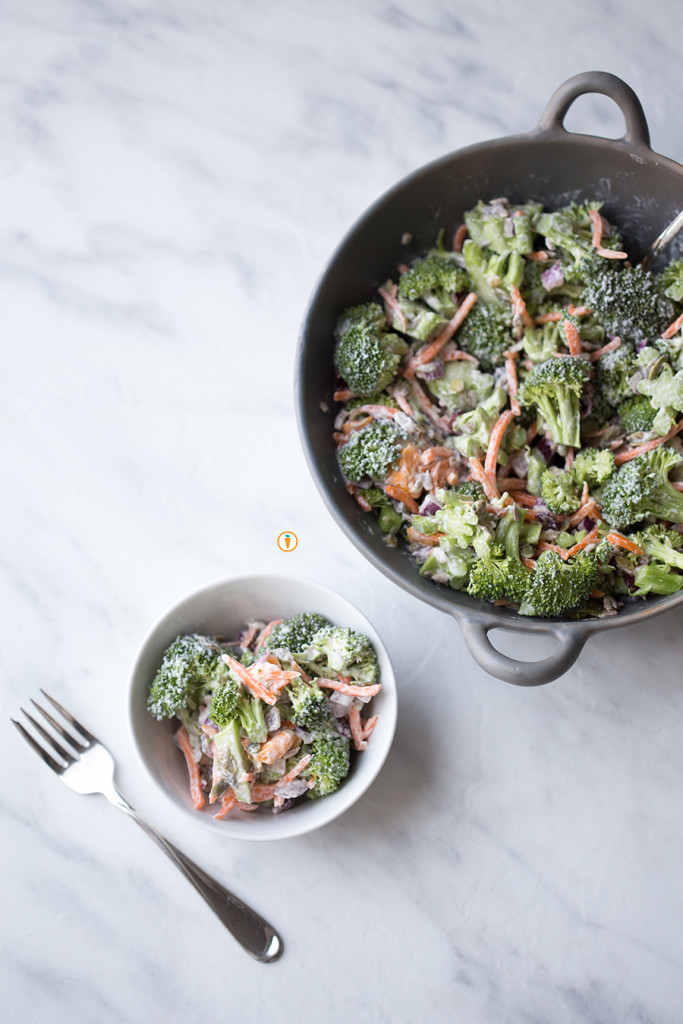
Arrrrrright, let’s move onto what you’re really here for.
The recipe.
- 3 cups broccoli, chopped
- 1 Gala apple, chopped
- ¼ cup red onion, chopped
- 1 cup grated or julienne carrots
- ¼ cup pumpkin seeds
- ¼ cup dried cranberries
- ½ cup chopped SqueaK'rs, cheddar (or grated)
- Dressing
- ¾ cup 2% M.F. Greek yogurt
- ⅓ cup mayonnaise
- 2 tablespoon honey
- Juice of ½ lemon
- Pinch of salt and pepper
- Pink of paprika
- Place all prepared veggies, apple, cranberries, pumpkin seeds and cheese into a bowl. Toss together.
- To prepare the dressing stir together Greek yogurt, mayonnaise, honey, lemon, salt, pepper and paprika.
- Pour the dressing (only half at a time) over the salad, ensuring the veggies are well coated. Let the salad sit in the fridge for 20 minutes to soften the broccoli. Add more dressing if desired.
- Serve and enjoy!
 Food photography done by the talented Ceone Dyck. To learn more about Ceone click here or follow her on Facebook.
Food photography done by the talented Ceone Dyck. To learn more about Ceone click here or follow her on Facebook.
Don’t forget to follow Carrots and Cake on Instagram to see tiny square snap shots of my life.
– With Love, Carrots and Cake,

